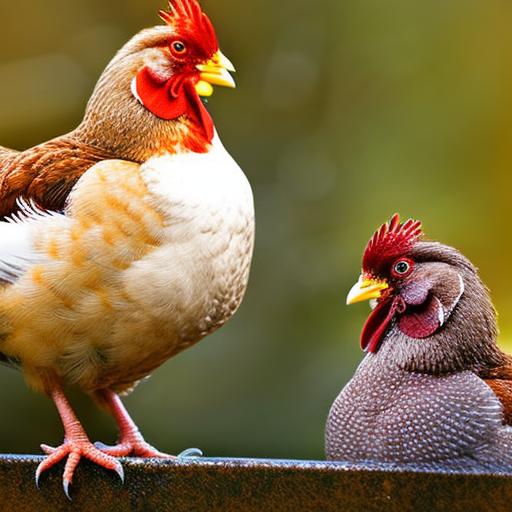Keeping chickens warm in cold weather is an important aspect of caring for these animals during the winter months. As temperatures drop, chickens are at risk of experiencing discomfort, illness, and even death if they are not properly protected from the cold. It is crucial for chicken owners to understand how to keep their flock warm and healthy during the winter season.
Key Takeaways
- Chickens have a unique anatomy that makes them susceptible to cold weather.
- Cold weather can cause stress, illness, and even death in chickens.
- Keeping chickens warm in cold weather is crucial for their health and safety.
- Insulating the chicken coop, providing ventilation, and using appropriate bedding are key steps in keeping chickens warm.
- Feeding chickens a balanced diet and ensuring they have access to clean water is also important during cold weather.
Understanding the anatomy of chickens
Chickens have a unique way of regulating their body temperature. Unlike humans, who maintain a constant internal body temperature, chickens are able to adjust their body temperature based on the external environment. They do this through a process called thermoregulation. Chickens have a higher body temperature than humans, typically ranging from 104 to 107 degrees Fahrenheit.
One of the key factors in keeping chickens warm is their feathers. Feathers provide insulation and help to trap warm air close to the chicken’s body. They also act as a barrier against wind and moisture, which can further lower the chicken’s body temperature. Feathers are essential for keeping chickens warm in cold weather.
The impact of cold weather on chickens
Cold weather can have a significant impact on chickens. When temperatures drop below freezing, chickens may experience discomfort and stress. They may huddle together to conserve body heat, which can lead to overcrowding and potential health issues. Additionally, cold weather can increase the risk of frostbite and hypothermia in chickens.
Frostbite occurs when the chicken’s comb, wattles, or feet are exposed to extreme cold for an extended period of time. The tissue freezes, leading to damage and potential loss of these body parts. Hypothermia, on the other hand, occurs when a chicken’s body temperature drops below normal levels. This can happen if the chicken is unable to generate enough heat or if it becomes wet in cold weather.
The importance of keeping chickens warm in cold weather
Keeping chickens warm in cold weather is essential for their health and well-being. When chickens are exposed to extreme cold, their bodies have to work harder to maintain a normal body temperature. This can put stress on their immune system and make them more susceptible to illness and disease. By keeping chickens warm, owners can help to prevent these issues and ensure the overall health of their flock.
In addition to the health benefits, keeping chickens warm also promotes their comfort and happiness. Chickens that are comfortable in their environment are more likely to lay eggs consistently and exhibit normal behavior. By providing a warm and cozy space for chickens during the winter months, owners can help to maintain their productivity and overall quality of life.
How to prepare your chicken coop for cold weather
Preparing your chicken coop for cold weather is an important step in keeping your flock warm and healthy. One of the first things you should do is winterize the coop. This involves sealing any cracks or gaps that could let in cold air or moisture. You can use caulk or weatherstripping to seal these areas.
Cleaning and organizing the coop is also crucial. Remove any debris or waste that may have accumulated, as this can create a damp environment that is not conducive to keeping chickens warm. Make sure the coop is well-ventilated but not drafty, as proper ventilation is important for maintaining air quality and preventing moisture buildup.
Insulating the chicken coop

Insulating the chicken coop is another effective way to keep chickens warm in cold weather. There are several insulation materials you can use, such as fiberglass insulation, foam board insulation, or even recycled denim insulation. The key is to insulate the walls, ceiling, and floor of the coop to create a barrier against the cold.
When insulating the coop, it’s important to consider ventilation as well. Insulation should not block airflow or prevent proper ventilation. You can install vents or windows that can be opened or closed as needed to regulate temperature and airflow.
Providing adequate ventilation in the chicken coop
While insulation is important for keeping chickens warm, it’s equally important to provide adequate ventilation in the coop. Ventilation helps to remove moisture, ammonia, and other gases that can build up in the coop and cause respiratory issues for the chickens. It also helps to regulate temperature and prevent condensation, which can lead to dampness and mold.
To provide adequate ventilation without letting in cold air, you can install vents or windows with adjustable openings. This allows you to control the airflow and temperature inside the coop. It’s important to regularly monitor the coop’s ventilation and adjust as needed to ensure a healthy environment for your chickens.
The role of bedding in keeping chickens warm
Bedding plays a crucial role in keeping chickens warm during cold weather. It provides insulation and helps to trap heat, keeping the coop cozy and comfortable. There are several bedding materials you can use, such as straw, wood shavings, or shredded paper. The key is to choose a material that is absorbent, easy to clean, and provides good insulation.
When choosing bedding material, avoid using materials that can become damp or moldy easily, such as hay or grass clippings. These materials can create a damp environment that is not conducive to keeping chickens warm. It’s also important to regularly clean and replace bedding to maintain cleanliness and prevent the buildup of waste.
Feeding chickens during cold weather
Feeding chickens a balanced diet is important year-round, but it becomes especially crucial during cold weather. Chickens require more energy to stay warm in cold temperatures, so it’s important to adjust their diet accordingly. Increase their intake of carbohydrates and fats, which provide energy and help to generate body heat.
You can supplement their diet with treats such as cracked corn or black oil sunflower seeds, which are high in fat and provide extra calories. It’s also important to provide fresh water at all times. In cold weather, water can freeze quickly, so consider using heated waterers or checking the water frequently to ensure it doesn’t freeze.
Ensuring the health and safety of your chickens in cold weather
Keeping chickens warm in cold weather is essential for their health and well-being. By understanding the anatomy of chickens and the impact of cold weather on them, you can take the necessary steps to provide a warm and comfortable environment for your flock. Preparing the chicken coop, insulating it, providing adequate ventilation, and choosing the right bedding are all important aspects of keeping chickens warm.
Feeding chickens a balanced diet and providing fresh water are also crucial during cold weather. By taking these steps, you can ensure the health and safety of your chickens during the winter months. Remember, a warm and cozy coop not only promotes their well-being but also helps to maintain their productivity and overall quality of life.
If you’re interested in learning more about how to keep chickens warm in cold weather, you might find this article on the Chicken Coop Country Diner from Poultry Wizard helpful. It provides valuable insights and tips on creating a cozy and insulated environment for your feathered friends during chilly winter months. Check it out here.
FAQs
What is the ideal temperature range for chickens?
Chickens are comfortable in temperatures ranging from 50-75°F. However, they can tolerate temperatures as low as 20°F if they are provided with adequate shelter and warmth.
Can chickens survive in cold weather?
Yes, chickens can survive in cold weather as long as they are provided with adequate shelter, warmth, and food. They have a natural ability to regulate their body temperature and can fluff up their feathers to keep warm.
How do chickens keep warm in cold weather?
Chickens keep warm in cold weather by fluffing up their feathers, which creates an insulating layer of air around their bodies. They also huddle together to share body heat and can roost in a sheltered area to stay out of the wind.
Can two chickens keep warm in cold weather?
Yes, two chickens can keep warm in cold weather by huddling together and sharing body heat. However, they will need adequate shelter and warmth to stay comfortable in extreme cold temperatures.
What kind of shelter do chickens need in cold weather?
Chickens need a dry, draft-free shelter in cold weather. The shelter should be well-ventilated to prevent moisture buildup, but not so drafty that it allows cold air to enter. It should also be insulated and have a heat source, such as a heat lamp or heated waterer, if necessary.
Meet Walter, the feathered-friend fanatic of Florida! Nestled in the sunshine state, Walter struts through life with his feathered companions, clucking his way to happiness. With a coop that’s fancier than a five-star hotel, he’s the Don Juan of the chicken world. When he’s not teaching his hens to do the cha-cha, you’ll find him in a heated debate with his prized rooster, Sir Clucks-a-Lot. Walter’s poultry passion is no yolk; he’s the sunny-side-up guy you never knew you needed in your flock of friends!







